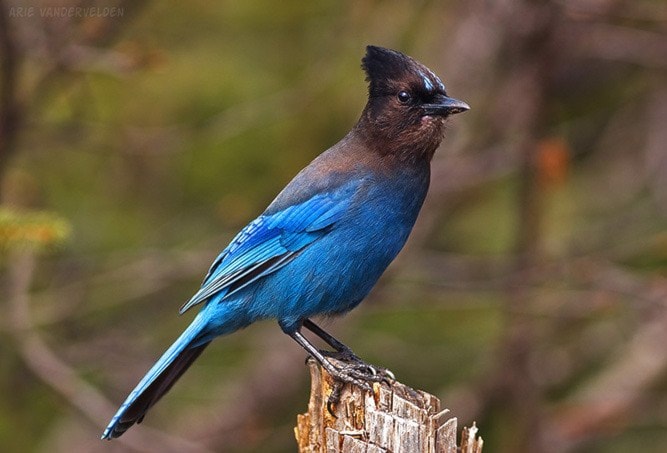The first sign that fall and winter are just around the corner, is the return of the Steller Jays.
Common visitors to the backyard feeders, they announce their presence with loud raucous squawks. Blue Jays (only found east of the Rockies), Steller Jays, crows and ravens are all part of the “corvid” family of birds. These birds are considered the most intelligent and adaptable family of birds in the world.
Steller Jays are strikingly beautiful with black heads, necks and upper bodies; their iridescent blue wing feathers are tipped with a barred pattern and their bellies are dark blue.
Unmistakable are the black crest feathers on their heads which can be raised or lowered depending on their disposition. Short rounded wings and a rounded tail provide jays with great agility and manoeuvrability when negotiating their way through the forest.
Vocally the Steller Jay is one of bird-lands most accomplished mimic, reproducing a variety of calls including that of the red tailed hawk and warbling songbirds. Found along the edges of the coniferous forests, these birds are particularly visible in summer months. Locally they will move to higher elevations returning to sea level in the winter. They will boldly approach campers and picnic sites aggressively demanding or helping themselves to food that may be left unattended.
Nuts, acorns, berries, seeds, eggs and young chicks make up this jay’s diet, they will also scavenge for fat and meat from an animal carcass. Extra food will be stored and hidden in a cache that will help them survive the winter months; they are particularly partial to suet feeders.
In the last few weeks, Steller Jays have been returning to our local areas. They are often seen in small flocks. They watch out for each other if danger approaches by noisily “mobbing” the intruder.
M.A.R.S. does not often rescue these birds and those we do see are a result of human intervention. In late August M.A.R.S. received a call from well-meaning people who found a baby Steller Jay and attempted to raise it in captivity. When they finally realized they were actually harming the bird rather than helping it, they brought it to our centre. Other than failing to thrive and losing its fear of humans, the jay was deemed releasable after it was isolated from humans, and happily it was successfully released.
Designated as B.C.’s provincial bird, Steller Jays are also protected under the Federal Migratory Bird Convention Act and the Provincial Wildlife Act.
With the fall rapidly changing to winter, more Steller Jays will be arriving into backyards to dine at the feeders. Many people also enjoy the last of the fall colours which often involves a trip up into the mountains.
A relative of the Steller Jay, the Gray Jay is also preparing for winter. It is very tempting to feed these wild birds but they need to store their winter food and an ample supply of nutritious food is critical to their survival.
If you want to enjoy the winter visitors in your backyard, make sure feeders are cleaned regularly: the “corvid” family of birds are potential carriers of several diseases that can be transferred to humans. Remember to be extra careful when driving at night, expect wildlife on the roads.
To report injured or abandoned wildlife please call 1-250-337-2021. For further information and upcoming events please visit our website at www.wingtips.org.
Sandy Fairfield is the educational co-ordinator for the Mountainaire Avian Rescue Society (MARS). The MARS column appears every second Thursday.
